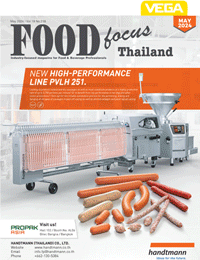เทคนิคการรีไซเคิลเอนไซม์เพื่อการผลิตน้ำตาลจากหัวบีท: เส้นทางสู่ความหวานที่ยั่งยืน Enzymatic Recycling Process for Sugar Beet Production: Pathway to Sustainable Sweetness
505 Views |

เทคนิคการรีไซเคิลเอนไซม์เพื่อการผลิตน้ำตาลจากหัวบีท: เส้นทางสู่ความหวานที่ยั่งยืน
Enzymatic Recycling Process for Sugar Beet Production: Pathway to Sustainable Sweetness
Translated and Compiled By: ณัฐชยา ดวงจรัส
Natchaya Duangjarus
Editorial Team
Food Focus Thailand Magazine
editor@foodfocusthailand.com
หัวบีท เป็นที่รู้จักกันดีในฐานะของพืชที่มีปริมาณซูโครสสูง ซึ่งมีศักยภาพในการเป็นวัตถุดิบตั้งต้นสำหรับกระบวนการผลิตน้ำตาลที่ละลายได้ มีการใช้งานในหลากหลายอุตสาหกรรม โดยกระบวนการไฮโดรไลซิสด้วยเอนไซม์ถือเป็นกระบวนการสำคัญที่จะเปลี่ยนคาร์โบไฮเดรตเชิงซ้อนภายในหัวบีทให้เป็นน้ำตาลที่ละลายได้
กระบวนการไฮโดรไลซิสหัวบีทด้วยเอนไซม์
กระบวนการไฮโดรไลซิสหัวบีทด้วยเอนไซม์เพื่อการผลิตน้ำตาลที่ละลายได้มีขั้นตอนที่สำคัญ ดังนี้
1. การเตรียมวัตถุดิบ: เช่น วิธีการระเบิดด้วยไอน้ำ (Steam explosion) การไฮโดรไลซิสด้วยกรด (Acid hydrolysis) หรือการปรับสภาพด้วยเบส (Alkaline treatment)
2. การเลือกใช้เอนไซม์: ซึ่งโดยทั่วไปจะใช้เอนไซม์ในกลุ่มคาร์โบไฮเดรสร่วมกัน เช่น เซลลูเลส เฮมิเซลลูเลส และเพกติเนส เพื่อช่วยย่อยพอลิแซ็กคาไรด์ตามลำดับของขนาดโมเลกุล
3. การเติมเอนไซม์: โดยเอนไซม์เหล่านี้จะเข้าไปกระตุ้นการแยกตัวของพันธะไกลโคซิดิกภายในโครงสร้างเซลลูโลส เฮมิเซลลูโลส และเพกติน แล้วปลดปล่อยโมเลกุลน้ำตาลออกมา
4. การทำปฏิกิริยาไฮโดรไลซิส: การทำปฏิกิริยาระหว่างเอนไซม์และสารตั้งต้นจะเข้าไปกระตุ้นปฏิกิริยาไฮโดรไลซิส นำไปสู่การสลายตัวของพอลิเมอร์ (Depolymerization) ของพอลิแซ็กคาไรด์ให้เป็นโมโนเมอร์น้ำตาลที่ละลายได้
5. การแยกน้ำตาลไปใช้: หลังจากกระบวนการไฮโดรไลซิสเสร็จสิ้นจะต้องนำไฮโดรไลเสตนั้นไปผ่านการแยกส่วนด้วยขั้นตอนการกรอง (Filtration) และการหมุนเหวี่ยง (Centrifugation) เพื่อนำส่วนของของเหลวที่เป็นน้ำตาลแยกออกจากส่วนกากที่ไม่สามารถละลายน้ำได้
การพัฒนากระบวนการผลิตน้ำตาลด้วยเทคนิคการรีไซเคิลเอนไซม์
งานวิจัยหนึ่งที่น่าสนใจ คือ การพัฒนากระบวนการรีไซเคิลเอนไซม์สำหรับกระบวนการผลิตน้ำตาลเพื่อลดปัจจัยเสี่ยงทางด้านเศรษฐกิจที่อาจเกิดขึ้นจากต้นทุนของเอนไซม์ที่มีราคาสูงด้วยการลดการใช้เอนไซม์ใหม่ ไฮโดรไลเสตที่ได้หลังจากการไฮโดรไลซิสหัวบีทด้วยส่วนผสมของเอนไซม์เซลลูเลสและเพกติเนส จะถูกนำไปหมุนเหวี่ยงและกรองผ่านเมมเบรนพอลิอีเทอร์ซัลโฟนที่แยกน้ำหนักโมเลกุล 50 กิโลดาลตัน เพื่อแยกเอนไซม์ออกจากสารละลายตัวอย่าง ซึ่งพบว่าการใช้วิธีรีไซเคิลเอนไซม์ในสถานะของเหลวพร้อมการเติมเอนไซม์ใหม่ร้อยละ 50 ในกระบวนการผลิต จะทำให้ได้ปริมาณของเหลวและผลผลิตน้ำตาลที่ใกล้เคียงกับการใช้เอนไซม์ใหม่ 100% นอกจากนี้ ยังศึกษาประสิทธิภาพของการไฮโดรไลซิสต่อเนื่องอย่างเป็นลำดับ (Sequential batches) ด้วยการใช้เอนไซม์รีไซเคิล ซึ่งพบว่าการไฮโดรไลซิสหัวบีทด้วยเอนไซม์รีไซเคิลอย่างเป็นลำดับสามารถผลิตได้อย่างน้อย 5 แบตช์ โดยไม่ส่งผลกระทบต่อปริมาณและคุณภาพของผลิตภัณฑ์สุดท้าย
Sugar beet, renowned for its high sucrose content, holds immense potential as a raw material for soluble sugar production, which finds applications in diverse industries. In the realm of sugar beet processing, enzymatic hydrolysis stands as a critical step in extracting these sugars by converting the complex carbohydrates within sugar beets into valuable soluble sugars.
Enzymatic Hydrolysis Process of Sugar Beet
The enzymatic hydrolysis of sugar beet for soluble sugar production involves several key steps as follows:
1. Pretreatment: The standard pretreatment methods include steam explosion, acid hydrolysis, or alkaline treatment.
2. Enzyme Selection: This generally uses a combination of carbohydrases such as cellulases, hemicellulases, and pectinases, each tailored to degrade the respective polysaccharide components.
3. Enzyme Addition: These enzymes catalyze the cleavage of glycosidic bonds within cellulose, hemicellulose, and pectin, then release soluble sugars.
4. Hydrolysis Reaction: The enzyme-substrate interaction catalyzes the hydrolysis reaction, leading to the depolymerization of polysaccharides into soluble sugar monomers.
5. Soluble Sugar Recovery: The mixture obtained after the complete hydrolysis process, known as hydrolysate, undergoes separation through filtration and centrifugation or other separation techniques to recover the soluble sugars from the insoluble residues.
Sugar Production Development with Enzymatic Recycling Process
One interesting research is the development of an enzyme recycling process for soluble sugar production to reduce the economic uncertainty raised by the high costs of enzymes by reducing fresh enzyme usage. The hydrolysate obtained from the beet hydrolysis by a mixture of cellulases and pectinases was centrifuged and then processed through a 50 kDa molecular weight cut-off (MWCO) polyethersulfone membrane to recover enzymes from the sample solution. This study found that liquid enzyme recycling with 50% fresh enzyme addition achieved a similar liquefaction extent and sugar yield compared to using 100% fresh enzyme. Moreover, they also demonstrated sequential batches of hydrolysis with enzyme recycling. These results concluded that at least five sequential batches of hydrolysis could be successfully conducted with liquid recycling without affecting either the quantity or quality of the final product.






